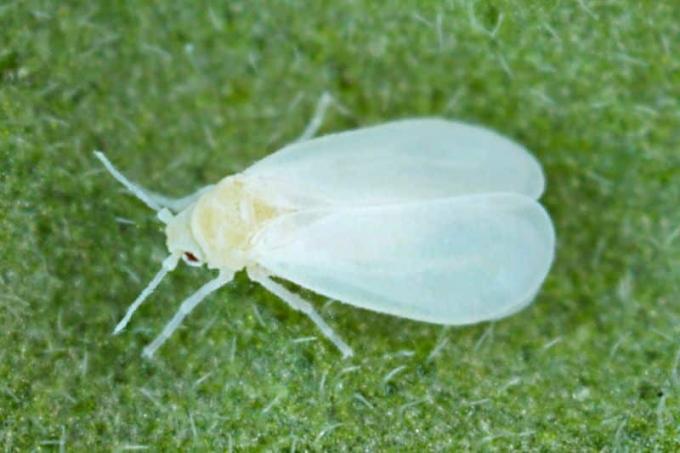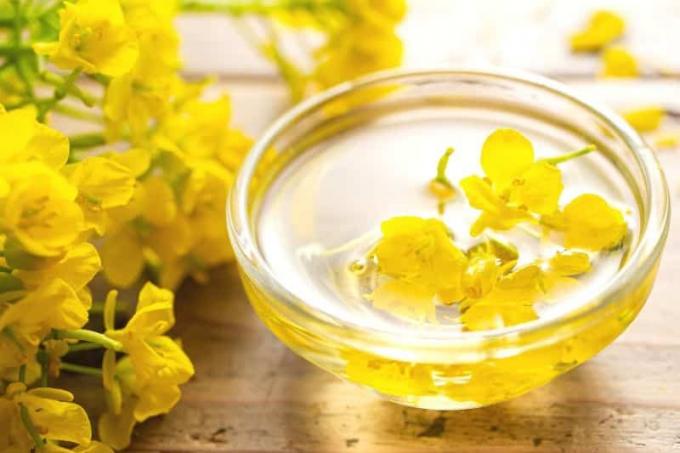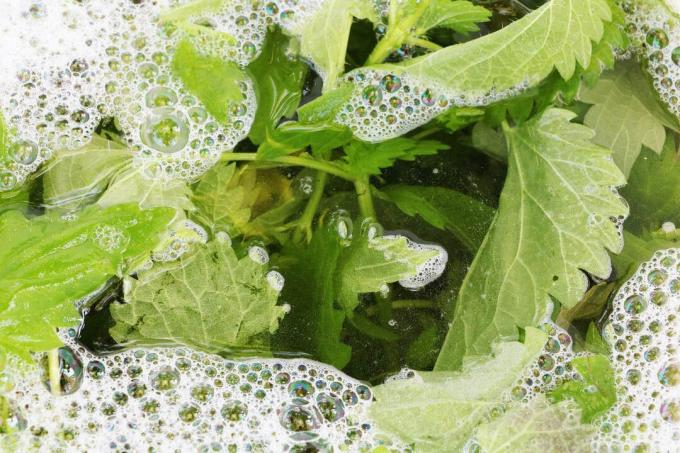
Cabbage flies are a horror for every gardener. They hardly spare any kind of cabbage and can cause great damage. The fight does not have to be chemical, various home remedies are also very effective against the white cabbage fly.
In a nutshell
- White cabbage fly actually a cabbage whitefly
- mainly affects cabbage vegetables such as cauliflower, savoy cabbage, kale
- Lay out the culture protection net as a preventive measure on the seed
- if there is a small infestation, simply hose it off
- Nettle broth good means of combating
Table of contents
- Identify white cabbage fly
- Fight with home remedies
- Spray made from rapeseed oil
- nettle manure
- garlic broth
- Solution of soft soap
- Neem oil solution
- Drive away with scents
- frequently asked Questions
Identify white cabbage fly
The whitefly is the cabbage whitefly (Aleyrodes proletella), the most common pest on the cabbage. As a rule, she sits under the leaves and when moving, huge swarms become visible.

The cabbage fly is easily recognizable by its typical appearance:
- Size: 1.5 to 2.0mm
- Wings powdered white with dark spots
- imbricated lying on abdomen
- Hind legs with strong jumping muscles
- Red eyes
- Eggs 0.2 mm long, white to yellowish
- Larvae yellowish, oval
The females lay up to 400 eggs in a circle on the underside of the leaf. In very dry and warm weather, 2 to 5 generations are possible per year. The first flies hatch after just four weeks.

A notice: The greenhouse whitefly (Trialeurodes vaporariorum) that occurs in the greenhouse has also spread also on various types of vegetables such as pumpkins, tomatoes, cucumbers, zucchini and peppers specialized.
Fight with home remedies
As soon as the first cabbage flies in the Vegetable patch are sighted, control is absolutely necessary in order to consistently counteract the proliferation of the pests. Hobby gardeners are increasingly using the following home remedies.
Tip: If the infestation is low, a strong jet of water is sufficient to combat it. To do this, shower the leaves thoroughly from top to bottom. Don't forget the stems and stalks.
Spray made from rapeseed oil

This mixture can be used to control larvae as well as adult flies. The production is quite simple:
- Mix rapeseed oil and water
- Mixing ratio: 7 parts water and 3 parts rapeseed oil
- Spray the plant thoroughly
- Don't forget the underside of the leaves
- do not use in direct sun
- Repeat every 4 to 5 days
Tip: It is important to constantly check your plants for the presence of these pests. Sometimes it is enough to remove infested plant parts and dispose of them in the residual waste. In the case of a severe infestation, only the complete removal of the entire plant will help.
nettle manure
Also one Manure from nettles can be used to combat. As a result, not only is whitefly combated efficiently, but the plants also receive an additional dose of nutrients at the same time.

- Finely chop 1 kg of fresh nettles or 150 to 200 g of dried ones
- add to 10 liters of water (rainwater or stagnant), stir
- mix in a handful of rock flour
- leave in a sunny place for two weeks
- stir daily
- The brew is ready when there is no more foam
- Dilute with water at a ratio of 1:10 for use
A notice: Do not use in sunshine, otherwise there is a risk of burns on the plant.
garlic broth
Also The white cabbage fly does not like the smell of garlic. The broth is used like the spray mixture from rapeseed oil.
- chop two cloves of garlic
- boil with a liter of water
- let cool, strain
- fill in a spray bottle

Solution of soft soap
The use of soft soap is also very effective in combating:
- Dissolve 30 g soft soap in warm water
- fill in spray bottle
- Spray the plant thoroughly
- leave on for an hour
- if necessary spray with water
- Repeat after a week
- alternatively, curd soap can also be used
- Dissolve 40 g grated in water
Neem oil solution
through the im neem oil The active ingredient azadirachtin contained in the treated plant becomes inedible for the pests. The first successes are already visible after a few days.

- Mix 10 to 15 ml of neem oil with a liter of water
- fill in a spray bottle
- do not use in the sun
- Treat the plant early in the morning
- repeat after a few days if necessary
A notice: Setting up yellow boards is also a good way to control adult cabbage flies. The attractants and color magically attract the flies to the sticky board.
Drive away with scents
The cabbage fly is very sensitive to the scents of various plants. Therefore, such plants are particularly well suited to expelling and combating the whitefly in advance. When planting near the vegetable patch, the flies can be prevented from laying eggs. are particularly suitable
- thyme (thymus)
- Savory (Satureja)
- Lavender (Lavandula)
- Basil (Ocimum basilicum)
- Celery (Apium graveolens)
- Marigold (tagetes)
- Cornflower (Cyanus segetum)
- Nasturtium (Tropaeolum majus)

Tip: In addition, planting in a mixed culture with tomatoes (Solanum lycopersicum) and leeks (Allium porrum) can kill the flies.
frequently asked Questions
The appearance of the "white fly on cabbage" is favored by dry, warm summer and autumn weather. She prefers to attack types of cabbage such as broccoli, cauliflower, kohlrabi, as well as rose, green and savoy cabbage.
Laying out fine-meshed, water-permeable culture protection nets directly on the seed is one measure. These remain there until harvest. The net should have a mesh size of 0.8 by 0.8 millimeters. The entire bed is covered. In order to prevent the pests from overwintering, all harvest residues of cabbage plants and other cruciferous plants must be removed. Setting up an insect hotel can attract beneficial insects such as parasitic wasps and ladybugs to control.
If possible, no chemical agents should be used in the vegetable garden to combat pests. They not only pollute the environment, but the sometimes toxic ingredients can also accumulate in the plants and fruits intended for consumption. Consumption would then be at the expense of health. These agents also pose a hazard to young children, pets, and wildlife.
The cabbage fly and its larvae suck the sap from the affected plants. The excretion of sticky and sugary honeydew takes place. This in turn is colonized by sooty mold and sooty mold which spoil the vegetables. If the infestation is weak, the cabbage can still be processed. Otherwise, disposal in the residual waste is necessary. There are also yellow-spotted leaves that later dry up. White dots and a layer of wax can be seen on the underside of the leaf.


